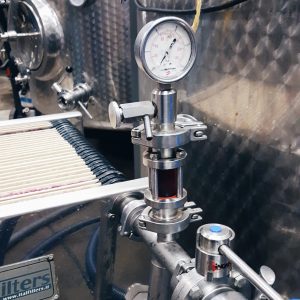
Photo by: Denise M. Gardner
Wine filtration seems to stump many of us. Some wines go through filtration with ease. Others… not so much.
But why?
Why is there such variation in filtration success?
Filtration challenges and reminders
Filtration is an essential part of the winemaking process, offering both clarification and microbial stability options for a wine. Filtration operations are often associated with pre-bottling techniques. This is because the filtration process is the last technique implemented to remove microorganisms before the wine goes into the bottle.
Though, winemakers beware.
All later stage operations that fall after the filter housing, including travel through hoses, pumps, and the bottling/packaging line, can contaminate the wine with microorganisms. This is why sulfur dioxide concentrations and sanitation practices are so essential to bottling operations.
Simply put, filtration technology is complicated. There is a lot to understand about the filtration system in addition to the media that is used in each filtration system.
There are fundamental differences between plate-and-frame systems versus lenticular filters or crossflow systems.
Keeping this is mind, it is imperative that winemakers review operation specifications for their system. Some tips that winemakers can use to better ease filtration operations:
- Have a current copy of the filter housing’s manual or instructions for use. This is often underestimated but can be a life saver for setting up the filtration unit properly.
- Know how to set up and operate the filtration system. Scott Labs provides videos on how to properly set up and run plate-and-frame, lenticular, or sterile filtration housings. Even if you did not purchase your unit from Scott Labs, these how to videos are incredibly helpful. It’s important to know how to properly clean, sanitize, and run the filtration unit to ensure it is working to specification.
- Store new filtration media properly to ensure the media’s longevity. Refer to the manufacturer’s storage recommendations if you have questions.
- If applicable, store filter cartridges properly after use. Double check the appropriate storage solution and how often the storage solution should be changed.
- At the end of each bottling season, discard leftover filter media. Begin each filtration/bottling season with new filter media.
- Know the common parameters affiliated with the media used (e.g., the amount of pressure that should be obtained during operation).
- For crossflow filtration units, it’s important to be aware that certain wine ingredients may not be added to the wine prior to filtration.
Where can I find more help?
The Production Guide: General Filtration Guidance provides details associated with common questions asked about filtration practices. DG Winemaking Clients and DGW Elite or Insider Members are encouraged to review this document for reminders associated with the filtration process. (To find out more about how to become a DGW Elite or Insider member, click here.)
I also recommend watching the Filtration FUNdamentals webinar (published in May 2021), taught by Scott Labs’ filtration expert, Maria Peterson. Maria discusses some major topics surrounding filtration including how filtration media work, QC checks prior to filtration, making sulfur dioxide additions pre-filtration, and general sanitation practices recommended for the bottling line. It’s such a fundamentally important webinar about filtration.
Winemakers of all experience levels should make time to watch it!
